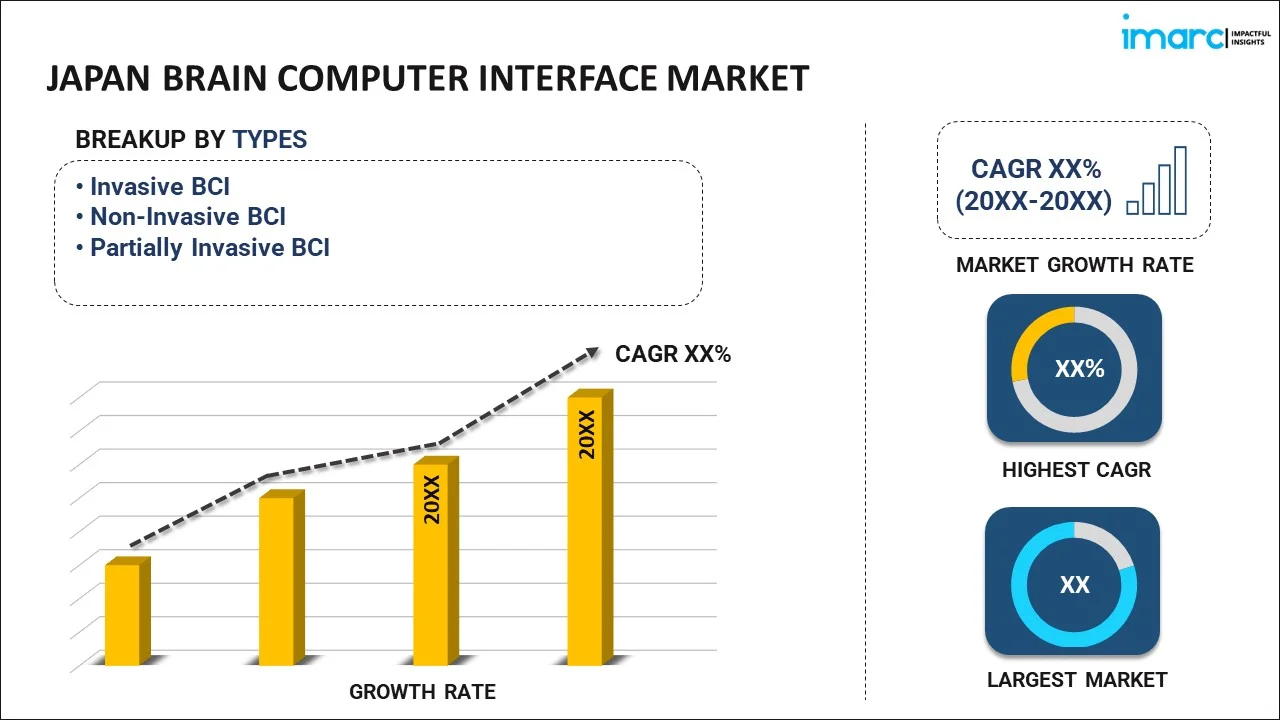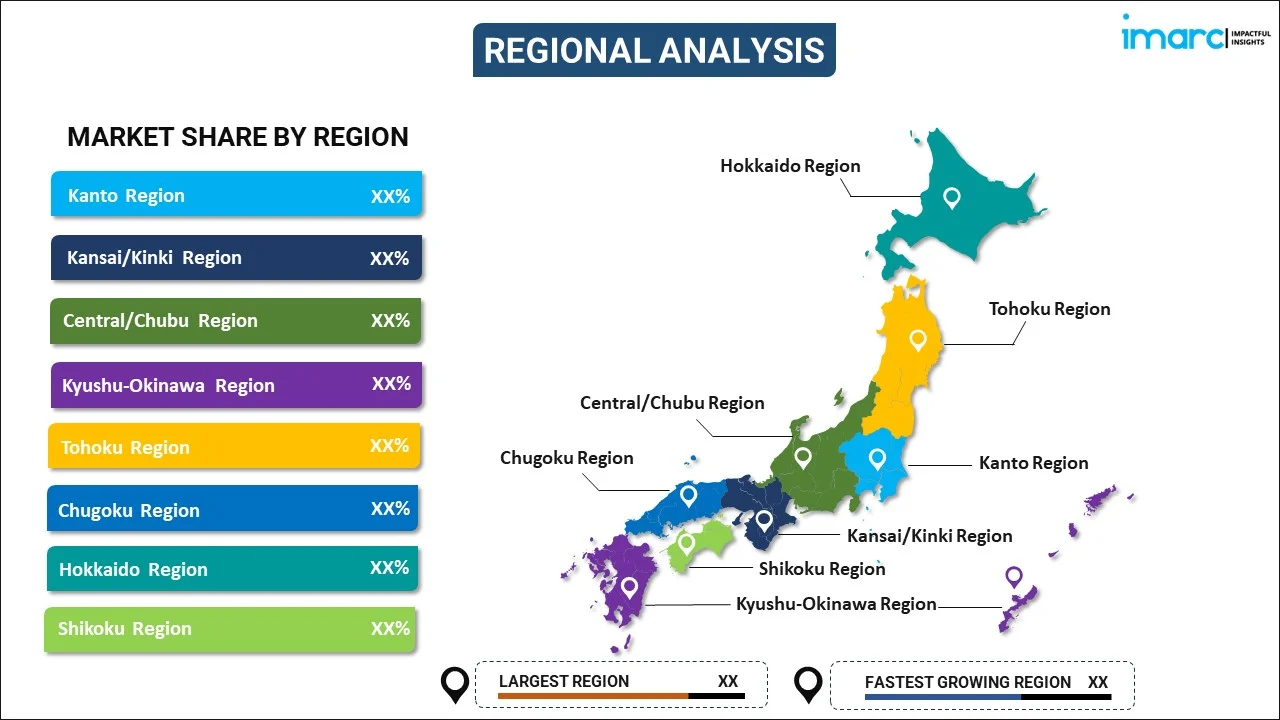
Japan Brain Computer Interface Market Report by Type (Invasive BCI, Non-Invasive BCI, Partially Invasive BCI), Application (Communication and Control, Healthcare, Smart Home Control, Entertainment and Gaming, and Others), and Region 2026-2034
Market Overview:
Japan brain computer interface market size reached USD 160.2 Million in 2025. Looking forward, IMARC Group expects the market to reach USD 625.2 Million by 2034, exhibiting a growth rate (CAGR) of 16.34% during 2026-2034. The widespread adoption of virtual reality (VR) applications in various industries, including healthcare and defense, is primarily driving the market growth.
|
Report Attribute
|
Key Statistics
|
|---|---|
|
Base Year
|
2025
|
|
Forecast Years
|
2026-2034
|
|
Historical Years
|
2020-2025
|
| Market Size in 2025 | USD 160.2 Million |
| Market Forecast in 2034 | USD 625.2 Million |
| Market Growth Rate 2026-2034 | 16.34% |
A brain-computer interface (BCI) is a technology system designed to acquire, analyze, and convert brain signals into commands that can be used with an artificial output device. This device serves the purpose of substituting, reinstating, enhancing, supplementing, and ameliorating the functions of the central nervous system (CNS). A brain-computer interface plays a vital role in the replacement or restoration of valuable functions for individuals afflicted by neuromuscular conditions like cerebral palsy, amyotrophic lateral sclerosis, or spinal cord injuries. Additionally, it proves beneficial in aiding the rehabilitation of individuals following a stroke or other similar disorders. Given its extensive application in facilitating communication and control for patients experiencing severe paralysis or those in a locked-in syndrome (LIS), there is a growing demand for BCI technology in Japan.
Japan Brain Computer Interface Market Trends:
The increasing aging population, alongside the rising incidence of neurodegenerative conditions such as epilepsy, Alzheimer's, and Parkinson's diseases, constitutes a significant factor bolstering the market growth. Furthermore, the incorporation of BCI technologies into various healthcare applications is on the rise. This, coupled with the growing emphasis on using BCI technologies for controlling internet of things (IoT) devices and virtual reality (VR) applications, serves as a driving force for market expansion. Additionally, owing to its exceptional accuracy, reliability, and enhanced security monitoring capabilities, BCI technology is finding application in the control of smart home functions like opening and closing doors, windows, and operating television or music systems. Moreover, ongoing technological advancements in bio-sensing, nanotechnology, bio-signal processing, and neuro-imaging techniques, alongside increased investments in research and development (R&D) endeavors, are presenting favorable prospects for the market. Furthermore, the escalating adoption of BCI within the defense and military sectors is expected to further catalyze market growth. In sum, a confluence of factors, including demographic shifts, healthcare integration, IoT, VR applications, technological advancements, and military adoption, collectively underpin the promising trajectory in the Japan brain-computer interface market over the forecasted period.
Japan Brain Computer Interface Market Segmentation:
IMARC Group provides an analysis of the key trends in each segment of the market, along with forecasts at the country level for 2026-2034. Our report has categorized the market based on type and application.
Type Insights:

- Invasive BCI
- Non-Invasive BCI
- Partially Invasive BCI
The report has provided a detailed breakup and analysis of the market based on the type. This includes invasive BCI, non-invasive BCI, and partially invasive BCI.
Application Insights:
- Communication and Control
- Healthcare
- Smart Home Control
- Entertainment and Gaming
- Others
A detailed breakup and analysis of the market based on the application have also been provided in the report. This includes communication and control, healthcare, smart home control, entertainment and gaming, and others.
Regional Insights:

- Kanto Region
- Kansai/Kinki Region
- Central/ Chubu Region
- Kyushu-Okinawa Region
- Tohoku Region
- Chugoku Region
- Hokkaido Region
- Shikoku Region
The report has also provided a comprehensive analysis of all the major regional markets, which include Kanto Region, Kansai/Kinki Region, Central/ Chubu Region, Kyushu-Okinawa Region, Tohoku Region, Chugoku Region, Hokkaido Region, and Shikoku Region.
Competitive Landscape:
The market research report has also provided a comprehensive analysis of the competitive landscape. Competitive analysis such as market structure, key player positioning, top winning strategies, competitive dashboard, and company evaluation quadrant has been covered in the report. Also, detailed profiles of all major companies have been provided.
Japan Brain Computer Interface Market Report Coverage:
| Report Features | Details |
|---|---|
| Base Year of the Analysis | 2025 |
| Historical Period | 2020-2025 |
| Forecast Period | 2026-2034 |
| Units | Million USD |
| Scope of the Report | Exploration of Historical and Forecast Trends, Industry Catalysts and Challenges, Segment-Wise Historical and Predictive Market Assessment:
|
| Types Covered | Invasive BCI, Non-Invasive BCI, Partially Invasive BCI |
| Applications Covered | Communication and Control, Healthcare, Smart Home Control, Entertainment and Gaming, Others |
| Regions Covered | Kanto Region, Kansai/Kinki Region, Central/ Chubu Region, Kyushu-Okinawa Region, Tohoku Region, Chugoku Region, Hokkaido Region, Shikoku Region |
| Customization Scope | 10% Free Customization |
| Post-Sale Analyst Support | 10-12 Weeks |
| Delivery Format | PDF and Excel through Email (We can also provide the editable version of the report in PPT/Word format on special request) |
Key Questions Answered in This Report:
- How has the Japan brain computer interface market performed so far and how will it perform in the coming years?
- What has been the impact of COVID-19 on the Japan brain computer interface market?
- What is the breakup of the Japan brain computer interface market on the basis of type?
- What is the breakup of the Japan brain computer interface market on the basis of application?
- What are the various stages in the value chain of the Japan brain computer interface market?
- What are the key driving factors and challenges in the Japan brain computer interface?
- What is the structure of the Japan brain computer interface market and who are the key players?
- What is the degree of competition in the Japan brain computer interface market?
Key Benefits for Stakeholders:
- IMARC’s industry report offers a comprehensive quantitative analysis of various market segments, historical and current market trends, market forecasts, and dynamics of the Japan brain computer interface market from 2020-2034.
- The research report provides the latest information on the market drivers, challenges, and opportunities in the Japan brain computer interface market.
- Porter's five forces analysis assist stakeholders in assessing the impact of new entrants, competitive rivalry, supplier power, buyer power, and the threat of substitution. It helps stakeholders to analyze the level of competition within the Japan brain computer interface industry and its attractiveness.
- Competitive landscape allows stakeholders to understand their competitive environment and provides an insight into the current positions of key players in the market.
Need more help?
- Speak to our experienced analysts for insights on the current market scenarios.
- Include additional segments and countries to customize the report as per your requirement.
- Gain an unparalleled competitive advantage in your domain by understanding how to utilize the report and positively impacting your operations and revenue.
- For further assistance, please connect with our analysts.
 Request Customization
Request Customization
 Speak to an Analyst
Speak to an Analyst
 Request Brochure
Request Brochure
 Inquire Before Buying
Inquire Before Buying




.webp)




.webp)












